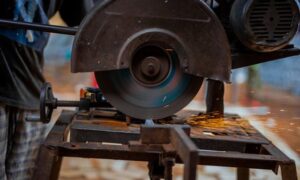
Regular maintenance of the aircraft is a must to guarantee the security and dependability of aircraft operations. Proper and consistent maintenance is essential to keep all types of aircraft in top working order, including private jets and commercial airlines. It involves a broad range of duties that trained engineers and technicians carry out, including inspections, repairs, and servicing. Potential flaws and defects can be found and fixed before they become significant issues by following stringent maintenance procedures. This improves the aircraft’s overall performance while lowering the possibility of mechanical problems occurring while it is in flight. Aircraft maintenance ensures maximum safety and comfort for both passengers and crew with careful attention to detail, adherence to industry standards, and the use of the following important pieces of equipment:
Aircraft Towing Bar
Tools used to maneuver and tow aircraft on the ground include an aircraft tow bar. These reliable tools enable ground technicians to maneuver the aircraft quickly in and out of hangars, repair bays, or parking spaces by securely attaching to the aircraft’s nose landing gear. Towbars must be carefully chosen to match the particular type of aircraft to ensure a precise and secure connection. An aircraft towing bar makes it simple for maintenance staff to move aircraft for ground work such as inspections or repairs, which enhances productivity and lowers the risk of damage.
Aviation Multimeter
A versatile electrical testing tool used to identify and resolve electrical system issues in aircraft is called an aviation multimeter. With the use of this portable instrument, maintenance personnel can measure voltage, current, resistance, and other electrical parameters to look for probable problems or anomalies. An aircraft multimeter’s numerous features and measuring capabilities enable accurate electrical system analysis, ensuring maximum performance and safety. This technology is essential for preserving the electrical integrity of the aircraft since it efficiently detects and fixes electrical problems.
Borescope
An aircraft’s engine, fuel system, or other crucial components can be visually inspected in difficult-to-reach places using a flexible optical tool called a borescope. Maintenance employees can visually analyze internal surfaces without disassembling the equipment with the aid of this portable device, which is made up of a long, narrow tube with a light source and camera at the tip. Technicians can detect wear, damage, or contamination by putting the borescope into small apertures or access points, allowing for prompt maintenance or repairs. Borescopes conserve time and resources by giving thorough visual evaluations and avoiding the necessity for pointless disassembly or component removal.
Aircraft Jacks
Heavy-duty lifting tools called aviation jacks are used to lift an airplane off the ground for various maintenance procedures. The undercarriage, landing gear, or other sections that need inspection or maintenance can be accessed by specialists using these sturdy hydraulic or mechanical tools, which are made to give steady and secure support. To suit a range of aircraft weights and designs, airplane jacks are available in a variety of sizes and types. Maintenance employees may safely complete activities like wheel replacements, gear checks, and structural repairs by using aircraft jacks, ensuring the aircraft is properly maintained and airworthy.
Non-Destructive Testing (NDT) Equipment
Non-destructive testing (NDT) equipment is essential for evaluating vital aircraft parts without causing harm. Utilizing NDT techniques, such as eddy current testing, magnetic particle inspection, and ultrasonic testing, it is possible to find concealed flaws or defects that could jeopardize the structural integrity of the aircraft. Technicians can evaluate the internal state of materials, welds, and other components using NDT technology, verifying that safety standards and regulations are being followed. Maintenance staff can correctly assess an aircraft’s structural health, find possible flaws, and take the necessary steps to keep it airworthy by using NDT procedures.
Conclusion
Aircraft maintenance is a vital foundation for safe and effective operations in the fast-paced world of aviation. It is a deft ballet of accuracy, knowledge, and steadfast devotion to maintaining aircraft in top shape. Every task in aviation maintenance, from simple inspections to intricate repairs, is extremely important. Every component functions flawlessly, every system runs smoothly, and every flight takes off with confidence because of the rigorous attention to detail and the utilization of cutting-edge technologies. Aircraft maintenance is the unseen force that keeps wings flying and skies safer than ever. Remember the unsung heroes working tirelessly behind the scenes to uphold the highest reliability and safety standards the next time you board a plane?






